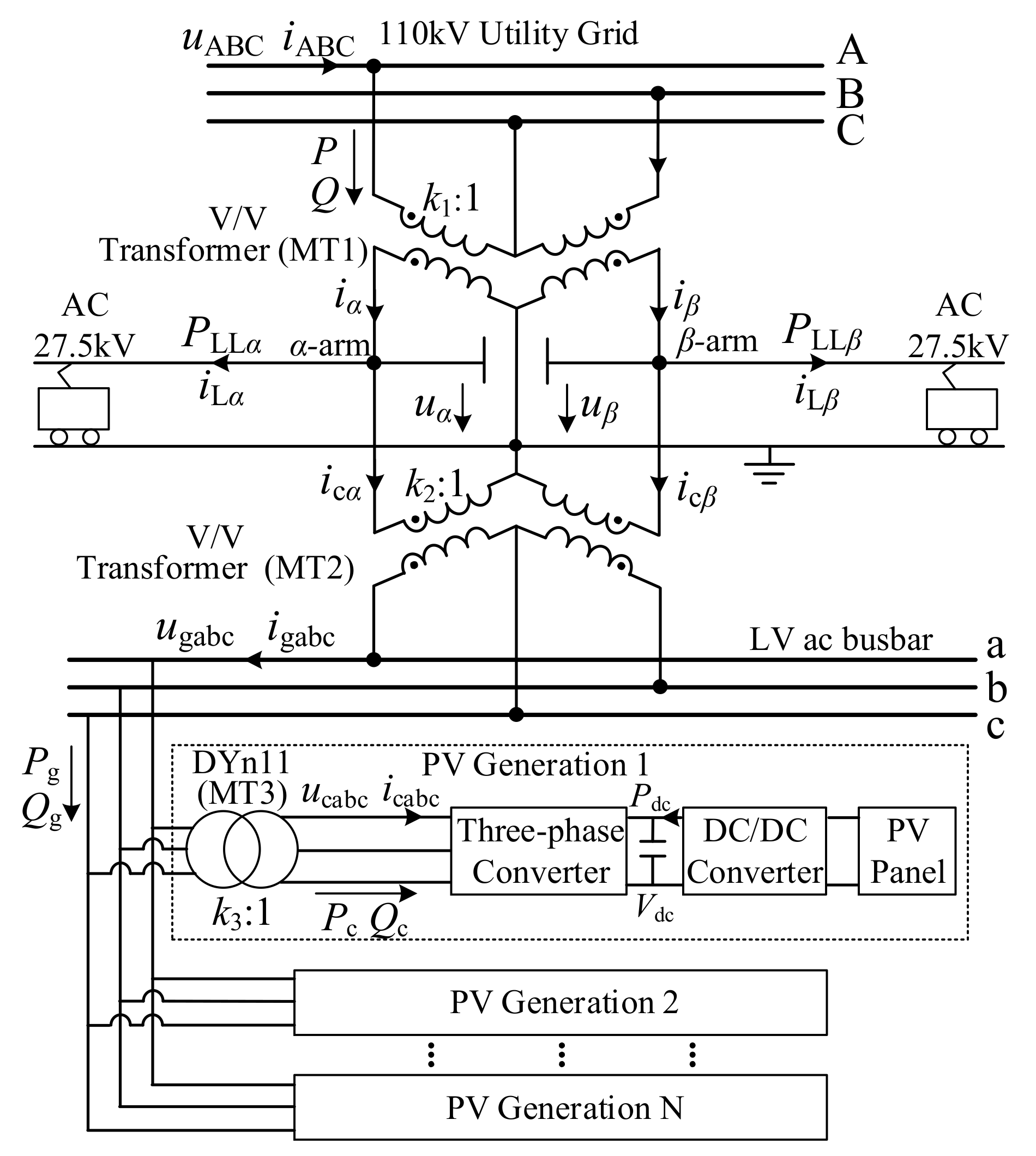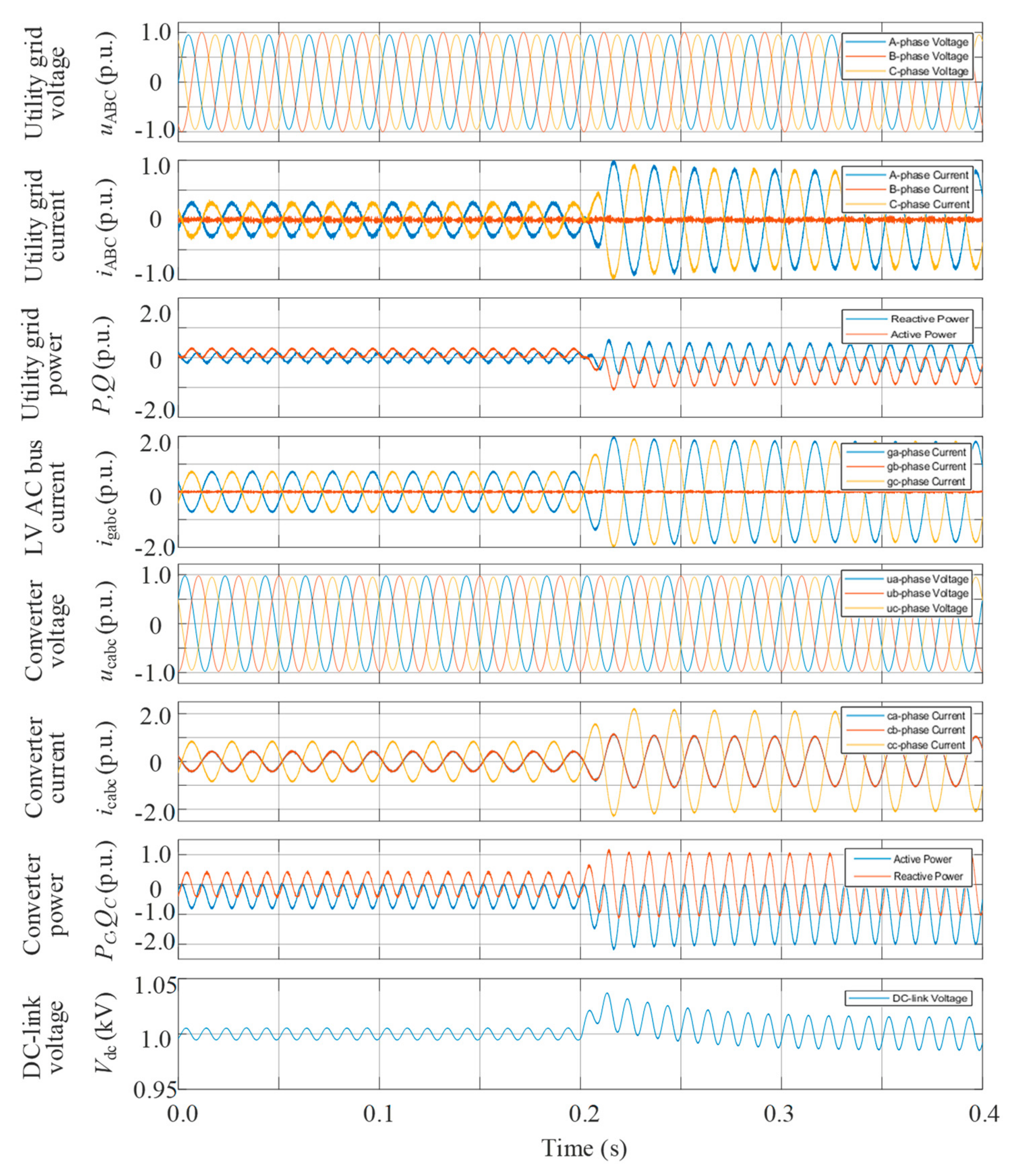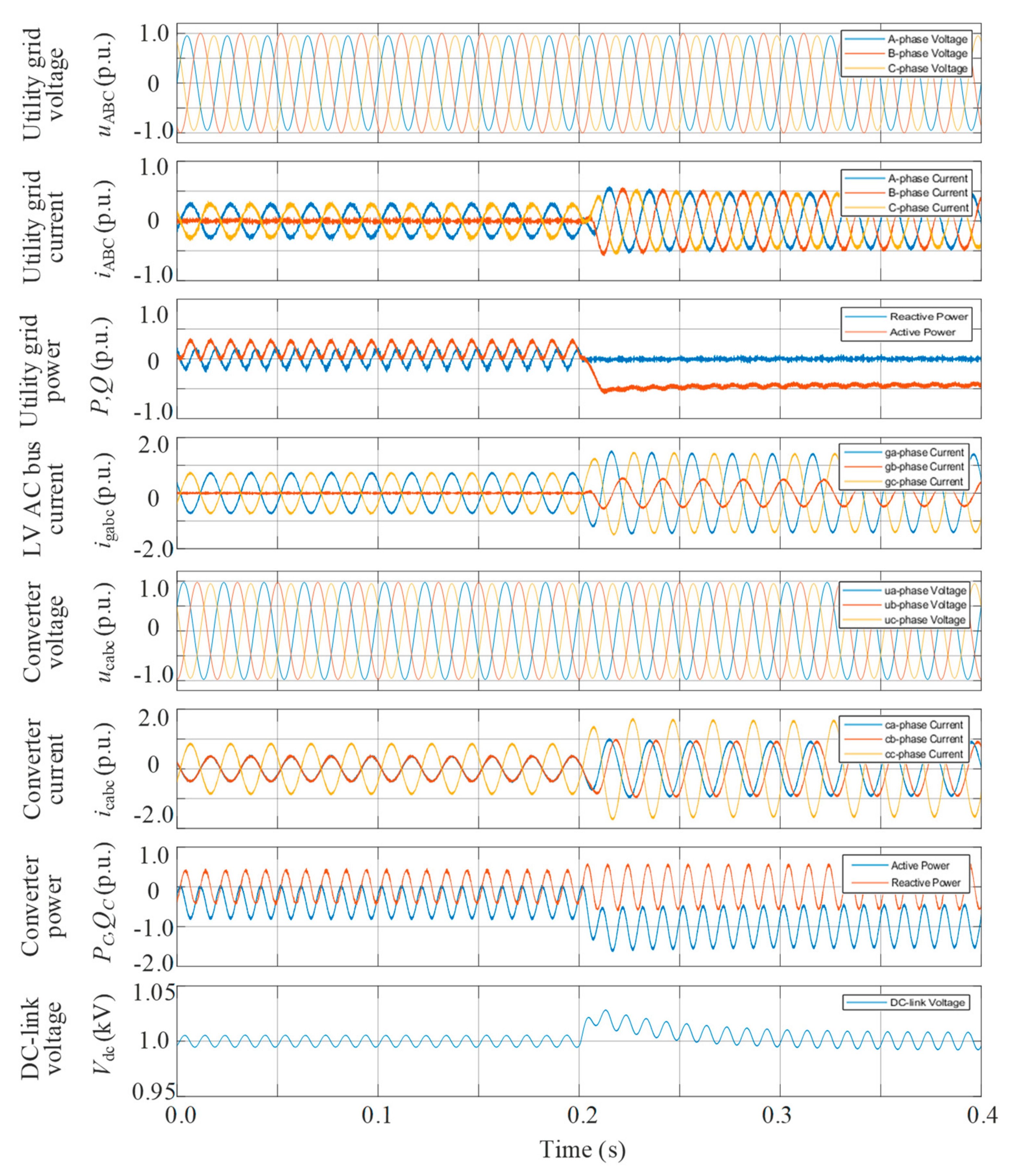Connection and Control Strategy of PV Converter Integrated into Railway Traction Power Supply System
Abstract
1. Introduction
2. Connection Topology
3. Control System
3.1. Current Tracking
3.2. Hybrid Current Reference
3.3. System Implementation
4. Simulation Results
5. Conclusions
Author Contributions
Funding
Conflicts of Interest
References
- Marczinkowski, H.M.; Barros, L. Technical Approaches and Institutional Alignment to 100% Renewable Energy System Transition of Madeira Island—Electrification, Smart Energy and the Required Flexible Market Conditions. Energies 2020, 13, 4434. [Google Scholar] [CrossRef]
- Mancini, F.; Nastasi, B. Solar Energy Data Analytics: PV Deployment and Land Use. Energies 2020, 13, 417. [Google Scholar] [CrossRef]
- Renewable Capacity Statistics. 2020. Available online: https://www.irena.org/publications/2020/Mar/Renewable-Capacity-Statistics-2020 (accessed on 8 March 2020).
- Morris, B.; Federica, F.; Hamed, J.K. The Evolution of Railway Power Supply Systems Toward Smart Microgrids. IEEE Electrif. Mag. 2020, 8, 12–23. [Google Scholar] [CrossRef]
- Global Energy Transformation: A Roadmap to 2050 (2019 Edition). Available online: https://www.irena.org/publications/2019/Apr/Global-energy-transformation-A-roadmap-to-2050-2019Edition (accessed on 10 April 2019).
- Hayashiya, H.; Suzuki, T.; Kawahara, K.; Yamanoi, T. Comparative study of investment and efficiency to reduce energy consumption in traction power supply: A present situation of regenerative energy utilization by energy storage system. In Proceedings of the 2014 16th International Power Electronics and Motion Control Conference and Exposition, Antalya, Turkey, 21–24 September 2014; pp. 685–690. [Google Scholar]
- Yoo, J.; Park, C.; Lee, J. A study on design of photovoltaic system using electrical railway stations. In Proceedings of the 19th International Conference of Electrical Machines Systems, Chiba, Japan, 13–16 November 2016. [Google Scholar]
- Riding Sunbeams: Powering Our Railways with Solar PV. Available online: https://www.ridingsunbeams.org/reports (accessed on 6 December 2017).
- Guangzhou Metro’s Yuzhu Depot Completes 5 MW of Largest Metro PV Power Station in China. Available online: https://www.sohu.com/a/283077992_180330 (accessed on 19 December 2018).
- Jia, L.; Ma, J.; Cheng, P.; Liu, Y. A Perspective on solar energy-powered road and rail transportation in China. CSEE J. Power Energy Syst. 2020, 6, 760–771. [Google Scholar]
- The Future of Rail: Opportunities for Energy and the Environment. Available online: https://www.iea.org/reports/the-future-of-rail (accessed on 3 January 2019).
- D’Arco, S.; Piegari, L.; Tricoli, P. Comparative Analysis of Topologies to Integrate Photovoltaic Sources in the Feeder Stations of AC Railways. IEEE Trans. Transp. Electrif. 2018, 4, 951–960. [Google Scholar] [CrossRef]
- Boudoudouh, S.; Maaroufi, M. Renewable Energy Sources Integration and Control in Railway Microgrid. IEEE Trans. Ind. Appl. 2018, 55, 2045–2052. [Google Scholar] [CrossRef]
- Wu, M.; Dai, Z.; Deng, W.; Gao, Y.; Chen, H.; Chen, W. Back-to-back PV generation system for electrified railway and its control strategy. In Proceedings of the 2017 IEEE Transportation Electrification Conference and Expo, Asia-Pacific (ITEC Asia-Pacific), Harbin, China, 7–10 October 2017. [Google Scholar]
- Ma, F.; Wang, X.; Deng, L.; Zhu, Z.; Xu, Q.; Xie, N. Multiport Railway Power Conditioner and Its Management Control Strategy with Renewable Energy Access. IEEE J. Emerg. Sel. Top. Power Electron. 2019, 8, 1405–1418. [Google Scholar] [CrossRef]
- Wang, Y.; Ruan, X.; Leng, Y.; Li, Y. Hysteresis Current Control for Multilevel Converter in Parallel-Form Switch-Linear Hybrid Envelope Tracking Power Supply. IEEE Trans. Power Electron. 2019, 34, 1950–1959. [Google Scholar] [CrossRef]
- Zhang, B.; Zhou, K.; Wang, D. Multirate Repetitive Control for PWM DC/AC Converters. IEEE Trans. Ind. Electron. 2014, 61, 2883–2890. [Google Scholar] [CrossRef]
- Li, J.; Wu, Z.; Gu, W.; Fu, H.; Zhang, X.-P. Aggregator service for PV and battery energy storage systems of residential building. CSEE J. Power Energy Syst. 2015, 1, 3–11. [Google Scholar] [CrossRef]
- Yu, Y.; Mi, Z.; Guo, X.; Niu, X.; Zheng, X.; Sun, C. Control design and implementation of a spiral spring energy storage system connected to a grid via PMSG. CSEE J. Power Energy Syst. 2018, 4, 339–351. [Google Scholar] [CrossRef]
- Fantino, R.A.; Busada, C.A.; Solsona, J.A. Optimum PR Control Applied to LCL Filters with Low Resonance Frequency. IEEE Trans. Power Electron. 2018, 33, 793–801. [Google Scholar] [CrossRef]
- Ma, K.; Chen, W.; Liserre, M.; Blaabjerg, F. Power Controllability of a Three-Phase Converter with an Unbalanced AC Source. IEEE Trans. Power Electron. 2014, 30, 1591–1604. [Google Scholar] [CrossRef]
- Zarei, S.F.; Mokhtari, H.; Ghasemi, M.A.; Peyghami, S.; Davari, P.; Blaabjerg, F. Control of Grid-Following Inverters Under Unbalanced Grid Conditions. IEEE Trans. Energy Convers. 2020, 35, 184–192. [Google Scholar] [CrossRef]
- Cheng, P.; Nian, H. Direct power control of voltage source inverter in a virtual synchronous reference frame during frequency variation and network unbalance. IET Power Electron. 2016, 9, 502–511. [Google Scholar] [CrossRef]
- Jia, J.; Yang, G.; Nielsen, A.H. A Review on Grid-Connected Converter Control for Short-Circuit Power Provision Under Grid Unbalanced Faults. IEEE Trans. Power Deliv. 2018, 33, 649–661. [Google Scholar] [CrossRef]
- Camacho, A.; Castilla, M.; Miret, J.; Borrell, A.; De Vicuna, L.G. Active and Reactive Power Strategies with Peak Current Limitation for Distributed Generation Inverters During Unbalanced Grid Faults. IEEE Trans. Ind. Electron. 2015, 62, 1515–1525. [Google Scholar] [CrossRef]
- Zhang, Z.; Wu, B.; Kang, J.; Luo, L. A Multi-Purpose Balanced Transformer for Railway Traction Applications. IEEE Trans. Power Deliv. 2009, 24, 711–718. [Google Scholar] [CrossRef]
- Golestan, S.; Guerrero, J.M.; Vasquez, J.C. Single-Phase PLLs: A Review of Recent Advances. IEEE Trans. Power Electron. 2017, 32, 9013–9030. [Google Scholar] [CrossRef]
- Karimi-Ghartemani, M.; Khajehoddin, S.A.; Jain, P.; Bakhshai, A. A Systematic Approach to DC-Bus Control Design in Single-Phase Grid-Connected Renewable Converters. IEEE Trans. Power Electron. 2013, 28, 3158–3166. [Google Scholar] [CrossRef]
- Merai, M.; Naouar, M.W.; Slama-Belkhodja, I.; Monmasson, E. An Adaptive PI Controller Design for DC-Link Voltage Control of Single-Phase Grid-Connected Converters. IEEE Trans. Ind. Electron. 2019, 66, 6241–6249. [Google Scholar] [CrossRef]
- Nian, H.; Song, Y. Optimised parameter design of proportional integral and resonant current regulator for doubly fed induction generator during grid voltage distortion. IET Renew. Power Gener. 2014, 8, 299–313. [Google Scholar] [CrossRef]
- Tao, H.; Hu, H.; Wang, X.; Blaabjerg, F.; He, Z. Impedance-Based Harmonic Instability Assessment in a Multiple Electric Trains and Traction Network Interaction System. IEEE Trans. Ind. Appl. 2018, 54, 5083–5096. [Google Scholar] [CrossRef]
- Hu, H.; Zhou, Y.; Li, X.; Lei, K. Low-Frequency Oscillation in Electric Railway Depot: A Comprehensive Review. IEEE Trans. Power Electron. 2020, 36, 295–314. [Google Scholar] [CrossRef]






| Parameter | Value | Parameter | Value |
|---|---|---|---|
| Grid line voltage | 110 kV | Converter capability | 5 MW |
| MT1 turn’s ratio k1 | 110 kV/27.5 kV | DC capacitance | 60 mF |
| MT2 turn’s ratio k2 | 27.5 kV/10 kV | DC-link voltage | 1000 V |
| MT3 turn’s ratio k3 | 10 kV/310 V | Locomotive load | 3 MW |
| Operation Mode | Time | Utility Grid | PV Converter | ||
|---|---|---|---|---|---|
| PSC | NSC | PSC | NSC | ||
| Mode I | 0.0–0.2 s | 0.22 p.u. | 0.21 p.u. | 0.40 p.u. | 0.40 p.u. |
| 0.2–0.4 s | 0.39 p.u. | 0.38 p.u. | 1.00 p.u. | 1.00 p.u. | |
| Mode II | 0.0–0.2 s | 0.22 p.u. | 0.21 p.u. | 0.40 p.u. | 0.40 p.u. |
| 0.2–0.4 s | 0.39 p.u. | 0.0 p.u. | 1.00 p.u. | 0.60 p.u. | |
Publisher’s Note: MDPI stays neutral with regard to jurisdictional claims in published maps and institutional affiliations. |
© 2020 by the authors. Licensee MDPI, Basel, Switzerland. This article is an open access article distributed under the terms and conditions of the Creative Commons Attribution (CC BY) license (http://creativecommons.org/licenses/by/4.0/).
Share and Cite
Cheng, P.; Wu, C.; Kong, H.; Blaabjerg, F.; Quan, Y. Connection and Control Strategy of PV Converter Integrated into Railway Traction Power Supply System. Energies 2020, 13, 5989. https://doi.org/10.3390/en13225989
Cheng P, Wu C, Kong H, Blaabjerg F, Quan Y. Connection and Control Strategy of PV Converter Integrated into Railway Traction Power Supply System. Energies. 2020; 13(22):5989. https://doi.org/10.3390/en13225989
Chicago/Turabian StyleCheng, Peng, Chao Wu, Huiwen Kong, Frede Blaabjerg, and Yu Quan. 2020. "Connection and Control Strategy of PV Converter Integrated into Railway Traction Power Supply System" Energies 13, no. 22: 5989. https://doi.org/10.3390/en13225989
APA StyleCheng, P., Wu, C., Kong, H., Blaabjerg, F., & Quan, Y. (2020). Connection and Control Strategy of PV Converter Integrated into Railway Traction Power Supply System. Energies, 13(22), 5989. https://doi.org/10.3390/en13225989






